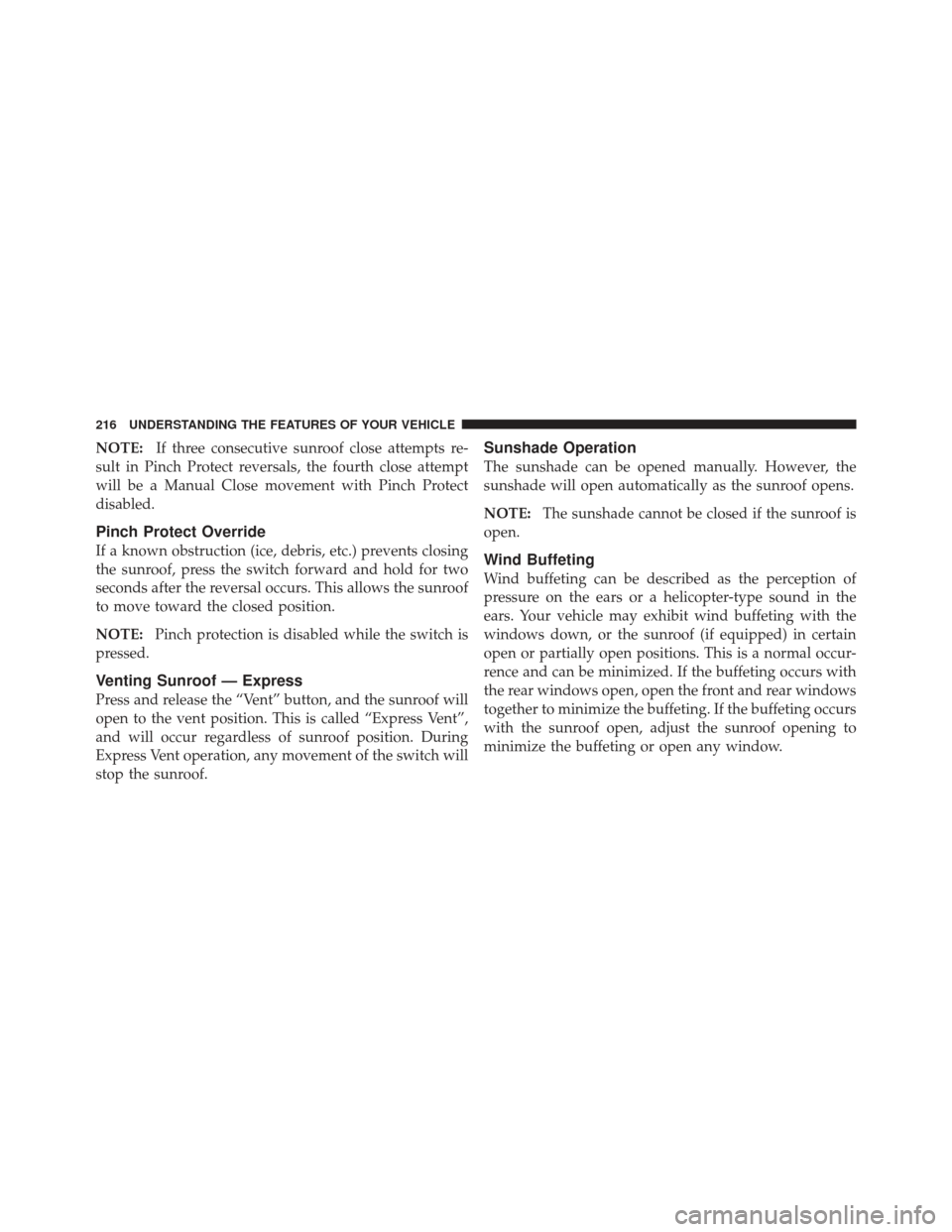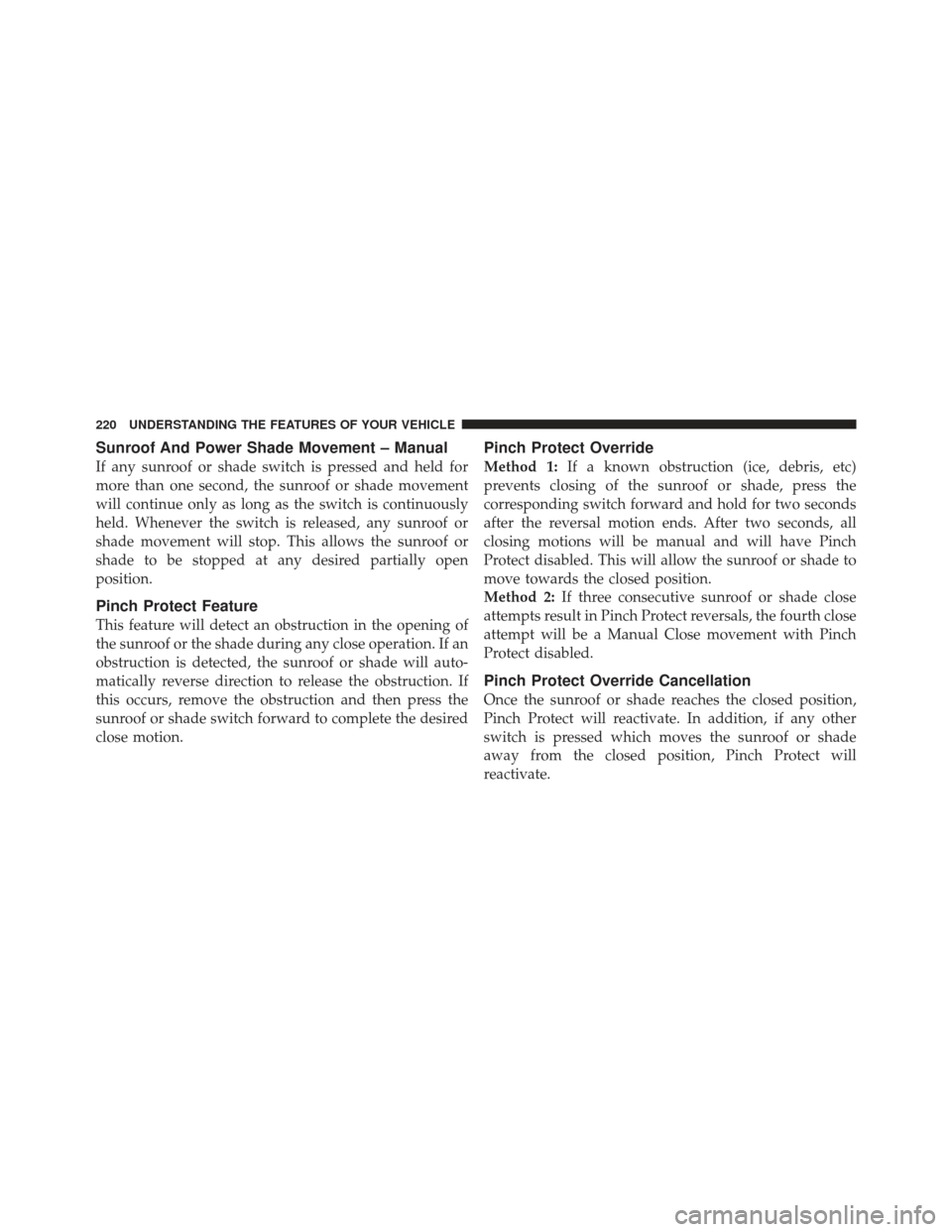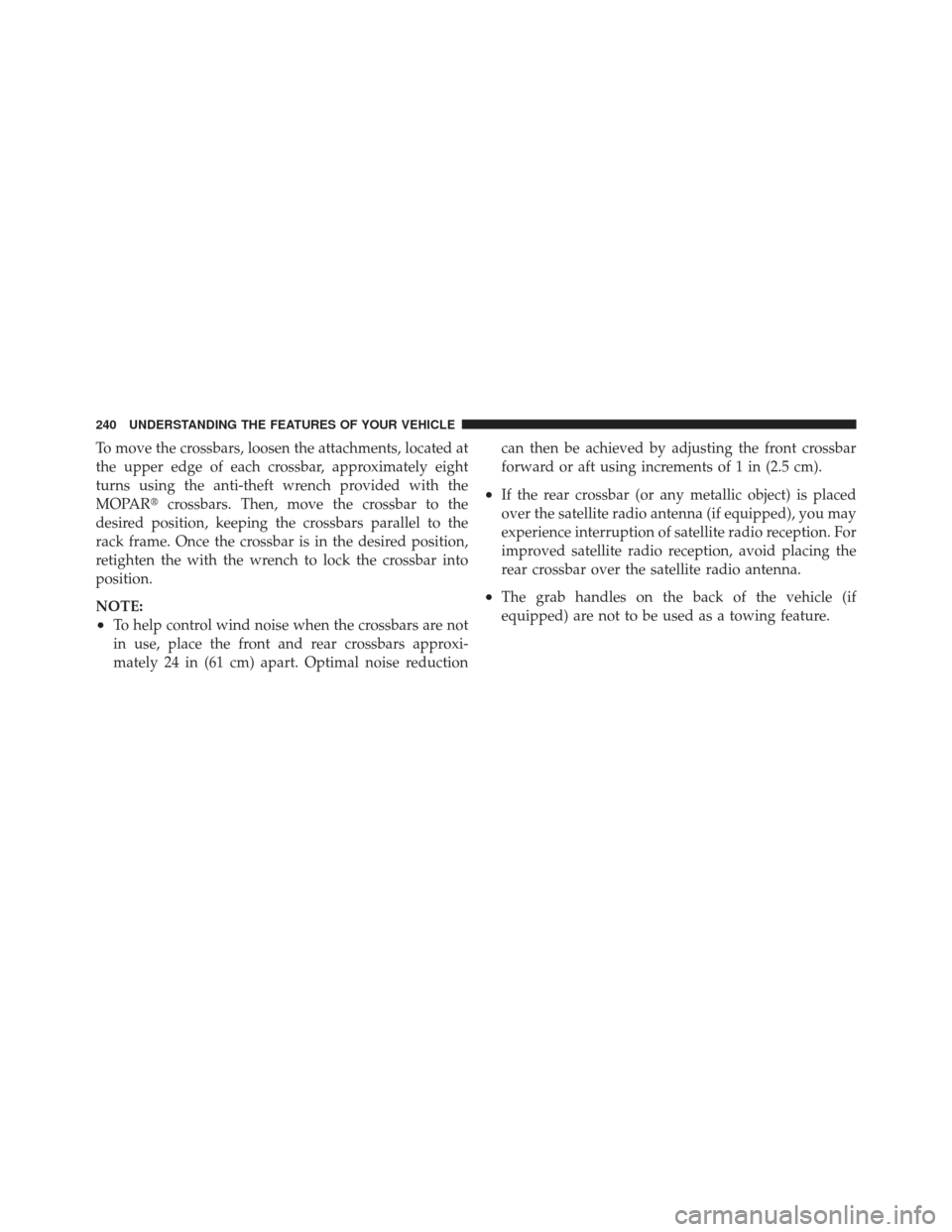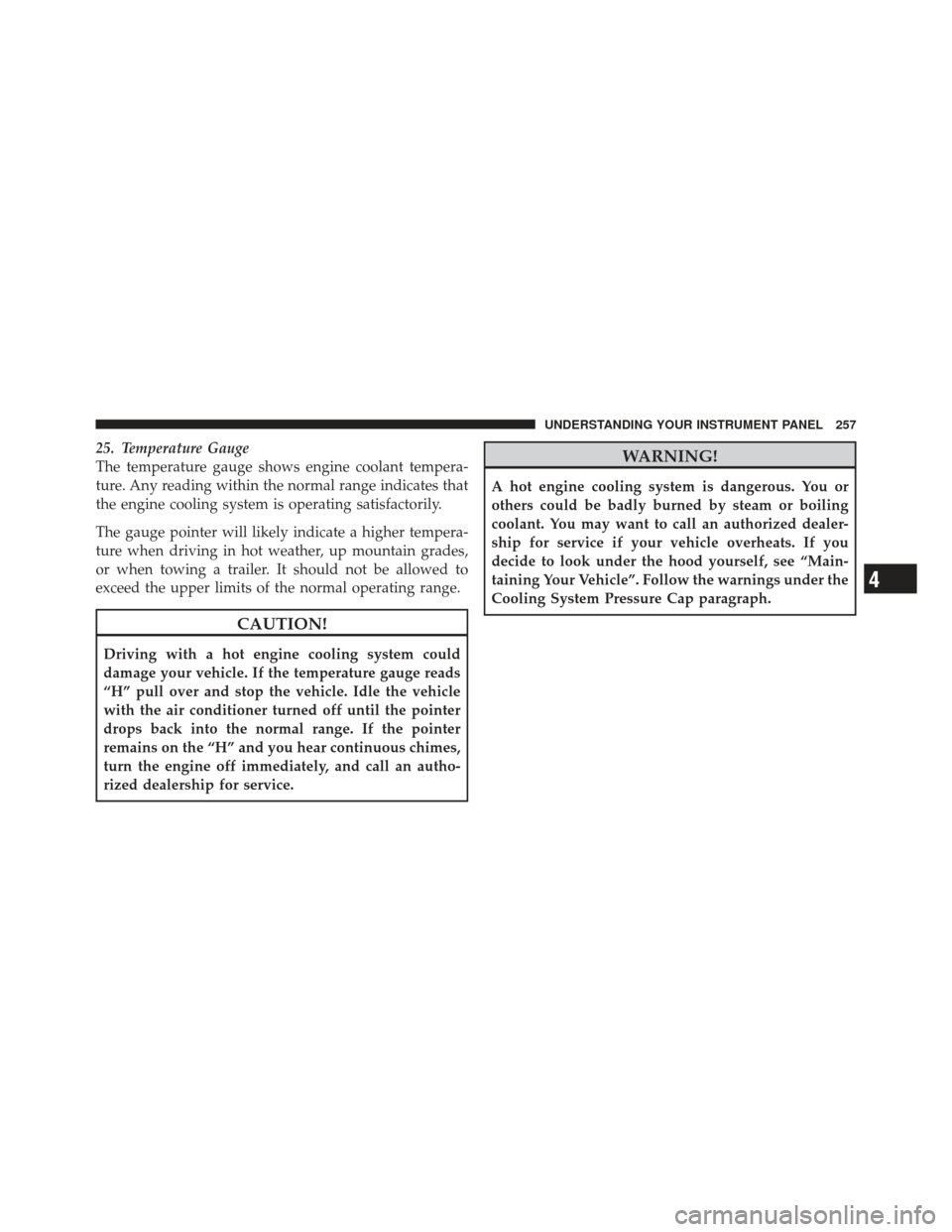Page 185 of 587

NOTE:Do not change the adjustment fasteners or pull
the sensor off of the bracket. Doing so may misalign the
sensor.
Store the sensor and bracket assembly in a safe location.
The wiring and connector must be stowed properly after
the sensor and bracket assembly is removed.
A connector plug is stowed on top of the bumper beam.
Insert the wiring connector into the connector plug.
NOTE: When the sensor is removed, Adaptive Cruise
Control, Normal Cruise Control, and Forward Collision
Warning will not be available. The cluster will display the
warning “ACC/FCW Unavailable - Service Radar Sen-
sor.” To reinstall the sensor and bracket assembly reverse the
process above. The fastener torque required to assembly
the bracket back to the beam is 6.6 ft lbs (9 Nm).
ACC Unavailable Warning
If the system turns off, and the EVIC displays “ACC/
FCW Unavailable, Vehicle System Error”, there may be a
temporary malfunction that limits ACC functionality.
Although the vehicle is still drivable under normal
conditions, ACC will be temporarily unavailable. If this
occurs, try activating ACC again later, following a key
cycle. If the problem persists, see your authorized dealer.3
UNDERSTANDING THE FEATURES OF YOUR VEHICLE 183
Page 205 of 587

WARNING!
•Drivers must be careful when backing up even
when using the ParkSense�Rear Park Assist Sys-
tem. Always check carefully behind your vehicle,
look behind you, and be sure to check for pedes-
trians, animals, other vehicles, obstructions, and
blind spots before backing up. You are responsible
for safety and must continue to pay attention to
your surroundings. Failure to do so can result in
serious injury or death.
(Continued)
WARNING! (Continued)
•Before using the ParkSense�Rear Park Assist
System, it is strongly recommended that the ball
mount and hitch ball assembly is disconnected
from the vehicle when the vehicle is not used for
towing. Failure to do so can result in injury or
damage to vehicles or obstacles because the hitch
ball will be much closer to the obstacle than the
rear fascia when the warning display turns on the
single flashing arc and sounds the continuous
tone. Also, the sensors could detect the ball mount
and hitch ball assembly, depending on its size and
shape, giving a false indication that an obstacle is
behind the vehicle.
3
UNDERSTANDING THE FEATURES OF YOUR VEHICLE 203
Page 218 of 587

NOTE:If three consecutive sunroof close attempts re-
sult in Pinch Protect reversals, the fourth close attempt
will be a Manual Close movement with Pinch Protect
disabled.
Pinch Protect Override
If a known obstruction (ice, debris, etc.) prevents closing
the sunroof, press the switch forward and hold for two
seconds after the reversal occurs. This allows the sunroof
to move toward the closed position.
NOTE: Pinch protection is disabled while the switch is
pressed.
Venting Sunroof — Express
Press and release the “Vent” button, and the sunroof will
open to the vent position. This is called “Express Vent”,
and will occur regardless of sunroof position. During
Express Vent operation, any movement of the switch will
stop the sunroof.
Sunshade Operation
The sunshade can be opened manually. However, the
sunshade will open automatically as the sunroof opens.
NOTE: The sunshade cannot be closed if the sunroof is
open.
Wind Buffeting
Wind buffeting can be described as the perception of
pressure on the ears or a helicopter-type sound in the
ears. Your vehicle may exhibit wind buffeting with the
windows down, or the sunroof (if equipped) in certain
open or partially open positions. This is a normal occur-
rence and can be minimized. If the buffeting occurs with
the rear windows open, open the front and rear windows
together to minimize the buffeting. If the buffeting occurs
with the sunroof open, adjust the sunroof opening to
minimize the buffeting or open any window.
216 UNDERSTANDING THE FEATURES OF YOUR VEHICLE
Page 222 of 587

Sunroof And Power Shade Movement – Manual
If any sunroof or shade switch is pressed and held for
more than one second, the sunroof or shade movement
will continue only as long as the switch is continuously
held. Whenever the switch is released, any sunroof or
shade movement will stop. This allows the sunroof or
shade to be stopped at any desired partially open
position.
Pinch Protect Feature
This feature will detect an obstruction in the opening of
the sunroof or the shade during any close operation. If an
obstruction is detected, the sunroof or shade will auto-
matically reverse direction to release the obstruction. If
this occurs, remove the obstruction and then press the
sunroof or shade switch forward to complete the desired
close motion.
Pinch Protect Override
Method 1:If a known obstruction (ice, debris, etc)
prevents closing of the sunroof or shade, press the
corresponding switch forward and hold for two seconds
after the reversal motion ends. After two seconds, all
closing motions will be manual and will have Pinch
Protect disabled. This will allow the sunroof or shade to
move towards the closed position.
Method 2: If three consecutive sunroof or shade close
attempts result in Pinch Protect reversals, the fourth close
attempt will be a Manual Close movement with Pinch
Protect disabled.
Pinch Protect Override Cancellation
Once the sunroof or shade reaches the closed position,
Pinch Protect will reactivate. In addition, if any other
switch is pressed which moves the sunroof or shade
away from the closed position, Pinch Protect will
reactivate.
220 UNDERSTANDING THE FEATURES OF YOUR VEHICLE
Page 242 of 587

To move the crossbars, loosen the attachments, located at
the upper edge of each crossbar, approximately eight
turns using the anti-theft wrench provided with the
MOPAR�crossbars. Then, move the crossbar to the
desired position, keeping the crossbars parallel to the
rack frame. Once the crossbar is in the desired position,
retighten the with the wrench to lock the crossbar into
position.
NOTE:
•To help control wind noise when the crossbars are not
in use, place the front and rear crossbars approxi-
mately 24 in (61 cm) apart. Optimal noise reduction can then be achieved by adjusting the front crossbar
forward or aft using increments of 1 in (2.5 cm).
•If the rear crossbar (or any metallic object) is placed
over the satellite radio antenna (if equipped), you may
experience interruption of satellite radio reception. For
improved satellite radio reception, avoid placing the
rear crossbar over the satellite radio antenna.
•The grab handles on the back of the vehicle (if
equipped) are not to be used as a towing feature.
240 UNDERSTANDING THE FEATURES OF YOUR VEHICLE
Page 250 of 587

INSTRUMENT CLUSTER DESCRIPTIONS
1. Tachometer
Indicates the engine speed in revolutions per minute
(RPM x 1000).
2. Airbag Warning LightThis light will turn on for four to eight seconds
as a bulb check when the ignition switch is first
turned to the ON/RUN position. If the light is
either not on during starting, stays on, or turns
on while driving, then have the system inspected at an
authorized dealer as soon as possible. Refer to “Occupant
Restraints” in “Things To Know Before Starting Your
Vehicle” for further information.
3. Malfunction Indicator Light (MIL) The Malfunction Indicator Light (MIL) is part of
an onboard diagnostic system called OBD II that
monitors engine and automatic transmission con-
trol systems. The light will illuminate when the key is in the ON/RUN position before engine start. If the bulb
does not come on when turning the key from OFF to
ON/RUN, have the condition checked promptly.
Certain conditions such as a loose or missing gas cap,
poor fuel quality, etc., may illuminate the light after
engine start. The vehicle should be serviced if the light
stays on through several of your typical driving cycles. In
most situations, the vehicle will drive normally and will
not require towing.
CAUTION!
Prolonged driving with the MIL on could cause
damage to the engine control system. It also could
affect fuel economy and drivability. If the MIL is
flashing, severe catalytic converter damage and
power loss will soon occur. Immediate service is
required.
248 UNDERSTANDING YOUR INSTRUMENT PANEL
Page 252 of 587

5. TOW/HAUL Indicator Light — If EquippedThis light will illuminate when the TOW/
HAUL button has been selected. The TOW/
HAUL button is located in the center of the
instrument panel (below the climate controls).
6. Turn Signal Indicator The arrows will flash with the exterior turn signals
when the turn signal lever is operated. A tone will
chime, and an EVIC message will appear if the turn
signals are left on for more than 1 mile (1.6 km).
7. High Beam Indicator Indicates that headlights are on high beam.
8. Front Fog Light Indicator — If Equipped This indicator will illuminate when the front fog
lights are on. 9. Hill Descent Control Indicator Light — If Equipped
The symbol indicates the status of the Hill
Decent Control (HDC) feature. The lamp will
be on solid when HDC is armed. HDC can only
be armed when the transfer case is in the “4WD
Low” position and the vehicle speed is less then 30 mph
(48 km/h). If these conditions are not met while attempt-
ing to use the HDC feature, the HDC indicator lamp will
flash on/off.
10. Electronic Vehicle Information Center (EVIC)
Display/Odometer Display
The odometer display shows the total distance the ve-
hicle has been driven.
U.S. Federal regulations require that upon transfer of
vehicle ownership, the seller certify to the purchaser the
correct mileage that the vehicle has been driven. If your
odometer needs to be repaired or serviced, the repair
technician should leave the odometer reading the same
250 UNDERSTANDING YOUR INSTRUMENT PANEL
Page 259 of 587

25. Temperature Gauge
The temperature gauge shows engine coolant tempera-
ture. Any reading within the normal range indicates that
the engine cooling system is operating satisfactorily.
The gauge pointer will likely indicate a higher tempera-
ture when driving in hot weather, up mountain grades,
or when towing a trailer. It should not be allowed to
exceed the upper limits of the normal operating range.
CAUTION!
Driving with a hot engine cooling system could
damage your vehicle. If the temperature gauge reads
“H” pull over and stop the vehicle. Idle the vehicle
with the air conditioner turned off until the pointer
drops back into the normal range. If the pointer
remains on the “H” and you hear continuous chimes,
turn the engine off immediately, and call an autho-
rized dealership for service.
WARNING!
A hot engine cooling system is dangerous. You or
others could be badly burned by steam or boiling
coolant. You may want to call an authorized dealer-
ship for service if your vehicle overheats. If you
decide to look under the hood yourself, see “Main-
taining Your Vehicle”. Follow the warnings under the
Cooling System Pressure Cap paragraph.
4
UNDERSTANDING YOUR INSTRUMENT PANEL 257